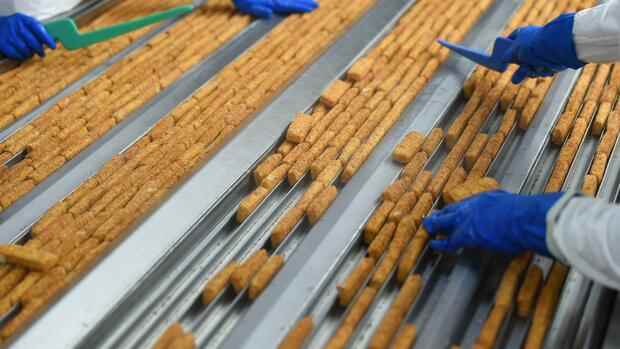Fish processors are having to cope with rising prices for flour and oil, and there are now bottlenecks in the supply of Alaska pollock.
(Photo: dpa)
Dusseldorf At Frozen Fish International in Bremerhaven, the production lines stand still at times. Normally, 48,000 tons of fish fingers and 20,000 tons of gourmet fillets are produced here every year – for example for the leading brand Iglo and private labels.
The plant, which belongs to the Iglo mother Nomad Foods, has now sent 440 employees from production and technology, some of them on short-time work. Iglo told the Handelsblatt.
“There has been a very high level of volatility in the supply chain over the last few weeks. This has led to delays in some raw materials, so that a continuous production process cannot be guaranteed,” Iglo explains the step.
The main reason: “The supply chain for Alaska pollock has come to a massive standstill,” explains Matthias Keller, Managing Director of the Federal Association of the German Fish Industry and Fish Wholesalers.
Top jobs of the day
Find the best jobs now and
be notified by email.
Corona and the Ukraine war are shaking up supply chains worldwide. Because a lot of food is produced in an international division of labour, supplies are faltering here too. There is hardly an example that shows this as clearly as the fish stick: 70 percent of the Alaska pollock required for this swims in Russian waters before it lands on the plate in the form of sticks. It is usually filleted in China, where work and transport are currently halted due to strict corona restrictions. In turn, it is breaded with wheat flour and sunflower oil, for both of which the Ukraine is an important export country.
This means that the fish stick is practically affected by both of the current major international crises – and is therefore becoming scarce and expensive.
From Russia via Korea and China to Germany
In 2021, Germany imported 139,000 tons of Alaska pollock, according to figures from the Federal Statistical Office. Much of the fish is caught by Russian trawlers, gutted on board and shipped to China for hand filleting. From there, the frozen fillet blocks are shipped in containers to Germany, where they are processed into fish fingers or gourmet fillets.
Corona has severely restricted capacities in Chinese ports and fish factories. Sabine Eichner, Managing Director of the German Frozen Food Institute, says: “The problem at the moment is how the raw fish gets to the German processing plants.” The lockdown alone in Shanghai, which has the world’s largest container port, got more than 600 container ships stuck, according to the market leader Iglo. “The delays in the supply chain for frozen fish, which is otherwise tightly scheduled, add up,” says Eichner.
For hygiene reasons, China has only allowed Alaska pollock to be imported in containers since the pandemic. Previously, the gutted fish was packed on pallets by Russian transport ships and shipped to China for filleting. The goods first have to be reloaded into containers at the port of Busan in Korea. “That costs a lot of time and money,” says fish association officer Keller. In addition, the availability of containers has been disrupted by the pandemic, and the costs for containers have multiplied.
There are bottlenecks in the Alaska Pollock supply chain. But Iglo’s warehouses are currently well stocked with fish fingers.
(Photo: Igloo)
And so it hits one of Germany’s favorite fish products: In 2020, sales of fish fingers in Germany had risen sharply by more than 14 percent. The high level remained stable in 2021, according to figures from the Frozen Institute. The Germans ate 74,338 tons of fish sticks.
Keller assures: “The fish finger is not dying out. It’s just less available at the moment.” Iglo, on the other hand, assures: “Iglo fish fingers are fully available, the warehouse is well stocked.” Neither retailers nor consumers need to worry. The American fisheries are the main supplier for Iglo Germany, and some of the fish comes from Russian waters, as is the case with many other manufacturers and retailers.
Difficult to switch to other fish
These supply relationships are now only used to a limited extent. Iglo is in the process of finding alternatives as quickly as possible: “However, a changeover is difficult in the short term and will take some time.” Frozen manufacturer Frosta is also currently examining which alternatives are suitable for the products instead of Alaska pollock.
According to Keller from the fish association, it is not possible to switch to other types of fish. Because of the catch quotas, there is a lack of availability. Cod, saithe, hake and pangasius from aquaculture are imported in significantly smaller quantities.
>> Read also: Eat Happy is rolling out its sushi islands in Europe
Possible EU import sanctions on Russian fish are also a cause for concern. Game fish and caviar from Russia may no longer be imported because of the Ukraine war. Russian Alaska Pollock is not yet subject to the sanctions. The US, on the other hand, has already banned imports. However, the United States itself is the largest fishing nation for Alaska pollock.
Russian trawlers fish around 400,000 tons of Alaska pollock a year. It is usually transported to China for hand filleting.
(Photo: imago/ITAR-TASS)
However, EU import sanctions against Alaska Pollock from Russian waters would actually jeopardize supplies in Europe. “You simply cannot replace the Russian pollock fishery,” said Patrick Barinet, managing director of Greenland Seafood, one of the largest white fish processors in Europe, to the trade magazine “Intrafish”.
The prices for fish fingers should not have reached the upper end yet.
More: The organic brand Followfood is now closing its Russian fish factory

